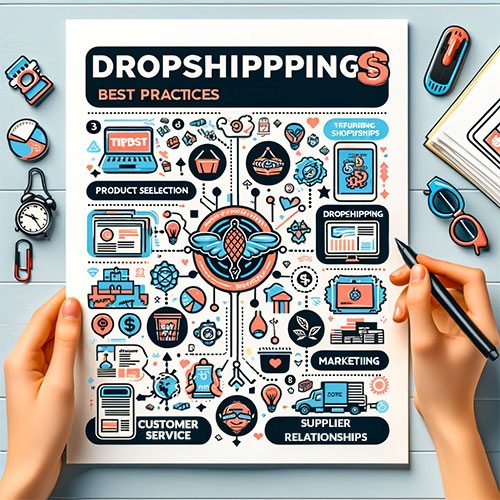Dropshipping For Teenagers @ 13, 14, 15, 16, 17, 18 and 19

Is It Legal for a Teenager to Run a Dropshipping Business?
The simple answer is yes it is legal for any teenager to run a dropshipping business. Dropshipping offers a great entrepreneurial opportunity for teenagers, but it’s important to understand the legal landscape. Legally, teenagers can engage in dropshipping, but there are nuances to consider.
Before diving in you may want to get up to speed on what is dropshipping?
- Age Restrictions: Most countries have regulations regarding the legal age for entering into binding contracts. Teenagers under the age of 18 might need a parent or guardian to sign legal documents on their behalf.
- Business Registration: Depending on the location, there may be requirements to register the business. This process can involve legal paperwork that might require parental involvement for minors.
- Tax Obligations: Understanding and managing tax obligations is crucial. Teenagers must be aware of the tax implications of running a business, including sales tax and income tax.
- Online Presence: Privacy laws, especially those protecting minors online, must be adhered to. Teenagers should be cautious about how much personal information they share on business websites and social media.
- Bank Accounts and Financial Transactions: Opening a business bank account typically requires being of legal age. Teenagers might need to operate under a parent’s account or seek alternatives that cater to younger individuals.
- Compliance with E-commerce Laws: E-commerce laws, including consumer rights and advertising standards, apply to all online businesses, including dropshipping. It’s important to ensure that the business complies with these laws to avoid legal issues.
Navigating the Legal Landscape
- Seek Guidance: Consulting with a legal professional can provide clarity on specific requirements and restrictions in your area.
- Parental Involvement: Involving a parent or guardian in the legal aspects of the business can ensure compliance and provide support.
- Educate Yourself: Learning about the legal aspects of running a business is invaluable. Many online resources and courses are available to help understand these complexities.
While teenagers can legally run a dropshipping business, it involves navigating certain legal considerations. With the right guidance and support, young entrepreneurs can successfully manage these aspects and thrive in their business ventures.
Dropshipping for Teenagers what’s the appeal?
Dropshipping is a buzzword in the world of e-commerce, especially appealing to the younger generation eager to dive into entrepreneurship. This innovative business model stands out for its accessibility and potential, making it a tantalizing option for teenagers looking to make their mark in the digital marketplace.
For teenagers, the appeal of dropshipping lies in its low entry barriers and flexibility. It’s a realm where the dynamism of the digital age meets the entrepreneurial spirit. With minimal initial investment and the need for limited physical space, dropshipping opens doors to the e-commerce world that were previously hard to unlock at a young age. It nurtures a sense of independence and introduces teenagers to key business concepts like supply chain management, online marketing, and customer service.
Moreover, in an era where teenagers are increasingly tech-savvy and connected, dropshipping aligns perfectly with their skills and interests. It offers a practical way to learn about online business, understand market trends, and develop valuable skills that are relevant in today’s digital economy.
In the following sections, we will delve deeper into what dropshipping entails, how it fits into the broader e-commerce landscape, and why it’s an especially fitting business model for teenagers. We’ll explore the nuances of starting a dropshipping business as a young entrepreneur, compare it with other online business models, and provide practical tips and insights for embarking on this exciting journey.

What is Dropshipping?
Dropshipping is a streamlined business model that’s reshaping the landscape of retail in the digital age. At its core, dropshipping is a method of retail fulfillment where a store doesn’t stock the products it sells. Instead, when a customer places an order, the retailer purchases the item from a third-party supplier, who then ships it directly to the customer. This means the retailer doesn’t handle the product directly, a significant departure from traditional retail models.
This business model differs markedly from conventional retail methods. In a traditional retail setting, a store would purchase inventory in bulk, store it, and then sell and ship it to customers. This requires significant upfront investment in inventory and storage space, as well as ongoing costs associated with inventory management and shipping logistics.
In contrast, dropshipping eliminates the need for substantial initial capital and reduces the risks associated with unsold inventory. It allows retailers to offer a wide range of products without worrying about storage space. Moreover, it enables quick adaptation to market trends, as the product offerings can be adjusted easily without the constraint of pre-purchased inventory.
For teenagers, the dropshipping model is particularly appealing because of its low startup costs and operational flexibility. It allows young entrepreneurs to start a business with limited resources and learn essential business skills such as market research, online advertising, and customer service. This model also teaches valuable lessons in supplier relations and the importance of a well-functioning supply chain.
Additionally, dropshippings digital nature aligns well with the skills and habits of the younger generation. Teenagers, growing up in a digital world, are typically adept at using the internet and social media, skills that are crucial in running an online business. This compatibility makes dropshipping a natural fit for young, aspiring entrepreneurs.
Exploration of Dropshipping for Teenagers
Dropshipping presents a world of opportunities for teenagers, offering a practical and accessible route into entrepreneurship. This business model is not just about selling products online; it’s about understanding market dynamics, developing digital marketing skills, and learning the intricacies of online customer service. For teenagers, dropshipping can be a gateway to developing a diverse set of skills while potentially earning income.
- Feasibility for Teenagers: One of the most significant advantages of dropshipping for teenagers is its feasibility. With minimal startup costs, it’s possible to launch a dropshipping business with limited financial resources, which is often a crucial factor for young entrepreneurs. Additionally, the flexibility to operate from anywhere with an internet connection makes it an ideal venture for students who need to balance schoolwork and other activities.
- Benefits for Young Entrepreneurs: The benefits of dropshipping for teenagers extend beyond the potential for earning. It serves as a practical education in the world of business, covering aspects like e-commerce platforms, digital marketing strategies, and customer relationship management. Engaging in dropshipping helps teenagers develop critical thinking and problem-solving skills, as they learn to navigate challenges and make informed decisions based on market trends and customer feedback.
- Moreover, running a dropshipping business exposes young entrepreneurs to the digital tools and platforms that are shaping the future of commerce. It offers firsthand experience in using e-commerce platforms like Shopify or WooCommerce, understanding search engine optimization (SEO), and leveraging social media for marketing.
- Limitations to Consider: However, it’s essential to recognize the limitations and challenges that come with dropshipping. The competition in the dropshipping space can be intense, with many sellers offering similar products. It requires creativity and strategic thinking to stand out in the market. Additionally, since the seller doesn’t handle the inventory, issues with supplier reliability and product quality can arise, which need to be managed effectively to maintain customer satisfaction.
- For teenagers, particularly, there might be legal and practical considerations to navigate, such as setting up a business entity, understanding tax obligations, and managing finances responsibly. These aspects, though challenging, provide valuable learning experiences in the realms of business operations and legal compliance.
In essence, dropshipping for teenagers is a balanced mix of opportunities and challenges. It offers a real-world platform to develop business acumen, digital skills, and entrepreneurial thinking. While it’s not without its hurdles, the insights and experiences gained from running a dropshipping business can be immensely valuable for young, aspiring entrepreneurs.

Dropshipping in the Broader E-Commerce Context
Dropshipping doesn’t exist in isolation; it’s a vital part of the broader e-commerce ecosystem. Understanding its place within this larger context helps teenagers appreciate the dynamics of online business and the opportunities available.
- E-Commerce Landscape: The e-commerce industry has been experiencing exponential growth, driven by technological advancements and changing consumer behaviors. Online shopping has become a norm rather than an exception, with a wide range of products and services available at the click of a button. This shift has created a fertile ground for business models like dropshipping, which align well with the digital nature of modern commerce.
- Trends and Growth: Several trends in e-commerce directly influence the potential and success of dropshipping businesses. The rise of social media platforms as marketing tools, the increasing use of mobile devices for online shopping, and the growing consumer preference for unique and niche products are notable factors. These trends provide a backdrop against which dropshipping can thrive, especially for teenagers adept at using social media and understanding emerging market trends.
- For young entrepreneurs, staying abreast of these trends and leveraging them is crucial. For example, using Instagram or TikTok for marketing can be highly effective, given the extensive reach and engagement these platforms offer. Understanding SEO and adapting to the evolving algorithms of search engines can also significantly impact the visibility and success of a dropshipping store.
- Relevance of Dropshipping: In the context of the e-commerce boom, dropshipping stands out as a model that’s especially relevant and accessible to teenagers. It allows them to participate in the e-commerce space without the need for extensive resources. The scalability of dropshipping businesses means that what starts as a small venture can grow into a significant enterprise with the right strategies and market conditions.
- Furthermore, the skills gained through running a dropshipping business – from digital marketing to customer analytics – are highly transferable and valuable in the broader e-commerce and digital marketing industries. For teenagers, this experience can open doors to various career paths in the digital economy.
- Dropshipping is an integral part of the e-commerce landscape, offering teenagers a unique opportunity to engage with the burgeoning online marketplace. By understanding and leveraging the trends in e-commerce, young entrepreneurs can position their dropshipping businesses for success and gain valuable skills for the future.
Comparative Analysis: Dropshipping vs. Other Online Businesses for Teens
When it comes to online entrepreneurship, teenagers have a variety of options. Dropshipping is just one of many, and understanding how it compares to other models like affiliate marketing or content creation is crucial for making an informed choice.

- Dropshipping vs. Affiliate Marketing: Affiliate marketing involves promoting other companies’ products and earning a commission for each sale or lead generated. Unlike dropshipping, where you sell products directly, affiliate marketing doesn’t require handling orders or customer service. It’s an excellent way for teenagers to start in online business with minimal risk. However, the earning potential can be more limited compared to dropshipping, where you have control over margins and pricing.
- Dropshipping vs. Content Creation: Content creation, such as blogging, YouTube channels, or podcasting, offers another avenue for online entrepreneurship. It revolves around building an audience and monetizing content through advertisements, sponsorships, or merchandise. While content creation can be highly rewarding and offer a creative outlet, it often requires more time to build a substantial audience and generate income. Dropshipping, in contrast, can potentially offer quicker financial returns, but it lacks the creative expression inherent in content creation.
- Suitability for Teenagers: The choice between dropshipping and other online businesses depends on several factors. Dropshipping is ideal for teenagers interested in learning about e-commerce, supply chain management, and online marketing. It’s well-suited for those who are looking for a more hands-on business experience.
On the other hand, affiliate marketing is a good fit for those who prefer a low-risk, low-involvement introduction to online business. It’s also suitable for teenagers who have or want to develop a strong presence on social media or a blog, as these platforms are critical for successful affiliate marketing.
Content creation is best for teens who are passionate about a particular subject and enjoy creating and sharing content. It requires patience and dedication to grow an audience, but it can be highly rewarding both personally and financially in the long run.
While dropshipping offers a more direct and hands-on approach to e-commerce and business management, affiliate marketing and content creation provide avenues that might better align with different interests and skills. Each model has its advantages and challenges, and the best choice depends on the teenager’s goals, interests, and resources.
Real-World Examples of Successful Teenage Dropshippers
One of the best ways to understand the potential of dropshipping for teenagers is through real-world examples. These success stories not only provide inspiration but also offer practical insights into what it takes to thrive in this business.
Here are two real-world examples of successful teenage dropshippers:
- Alex Philip:
- Age and Earnings: Alex Philip, at just 15 years old, achieved over $2 million in sales from his Alibaba dropshipping business.
- Background: Alex began his e-commerce journey at the age of 11, selling Pokémon toys on Amazon, motivated by his father, a businessman.
- Challenges and Learning: After facing a setback with Amazon due to customer complaints about defective items, Alex shifted to dropshipping. He learned vital skills in conversion rate optimization, online store management, and running successful Facebook ad campaigns.
- Key Lessons: His story underscores the importance of focusing on learning and improvement, being fearless in taking action, and the benefit of employing a virtual assistant to manage workload.
- Matīss:
- Age and Initial Success: At 18, Matīss grew his e-commerce store, Artsy Wall, to $70,000 in revenue within six months, averaging $3,000 profit per month.
- Journey and Challenges: Matīss’s journey wasn’t straightforward; it took three failed dropshipping stores before finding a successful format.
- Dropshipping Model Benefits: He found dropshipping appealing as it didn’t require upfront inventory investment. Matīss used Shopify to manage his store, effectively leveraging dropshipping suppliers to minimize his inventory risk.
- Finding Success: His first significant success was with a store selling Christian products, combining a well-defined audience, niche products, and influencer marketing. Artsy Wall, initially a side project, quickly became successful, generating over $8,000 in the first two months.
- Marketing Strategies: Matīss focused on mastering Facebook ads, adopting a data-driven marketing approach. This strategy led to a significant sales spike for Artsy Wall, reaching over $45,000 in a single month by efficiently using Facebook advertising and targeting lookalike audiences.
These examples highlight the potential for success in dropshipping for teenagers, showcasing the importance of perseverance, learning from failures, understanding the e-commerce landscape, and effectively utilizing digital marketing strategies.
- Case Studies of Teenage Dropshippers: There are numerous instances of teenagers who have turned their dropshipping ventures into profitable businesses. These young entrepreneurs often start with limited resources but leverage their understanding of digital platforms and market trends to build successful online stores. They typically focus on niche markets, use social media effectively for marketing, and establish reliable supplier relationships.
- Key Strategies for Success: Common strategies that emerge from these success stories include identifying unique product niches, creating engaging online content, and using targeted social media advertising. Successful teenage dropshippers also emphasize the importance of customer service, recognizing that positive customer experiences lead to repeat business and word-of-mouth referrals.
Another critical factor is continuous learning and adaptation. The digital marketplace is dynamic, and what works today might not work tomorrow. These young entrepreneurs stay ahead by keeping up with e-commerce trends, experimenting with new marketing strategies, and constantly seeking ways to improve their business operations. - Lessons Learned: The journeys of teenage dropshippers are filled with valuable lessons. They highlight the importance of perseverance, creativity, and adaptability in the world of online business. These stories also shed light on the practical aspects of dropshipping, such as dealing with shipping delays, handling returns, and managing customer expectations.
Moreover, these case studies demonstrate that age is not a barrier to success in the digital marketplace. With determination, a willingness to learn, and the ability to leverage digital tools, teenagers can achieve significant accomplishments in dropshipping.
In essence, the real-world examples of successful teenage dropshippers serve as powerful testimonials to the viability of this business model for young entrepreneurs. They provide tangible proof that with the right approach, dedication, and use of digital skills, teenagers can not only participate in the world of e-commerce but also excel in it.
Common Misconceptions about Dropshipping as a Teenager
While dropshipping offers many opportunities for teenagers, there are also common misconceptions that need to be addressed. Understanding these myths and the realities behind them is essential for any young entrepreneur considering this business model.

- Misconception 1: Dropshipping is Easy and Guarantees Quick Profit One of the most pervasive myths is that dropshipping is an effortless route to making money quickly. In reality, like any business, dropshipping requires hard work, dedication, and patience. Success often involves dealing with challenges like finding the right suppliers, building a customer base, and creating effective marketing strategies. While it’s possible to achieve profitability, it’s not guaranteed and typically doesn’t happen overnight.
- Misconception 2: No Investment is Needed Another common misconception is that dropshipping requires no financial investment. Although it has lower upfront costs compared to traditional retail, some investment is necessary. Expenses can include website hosting, domain registration, marketing and advertising costs, and sometimes purchasing samples for quality assurance. It’s essential for teenagers to understand and plan for these potential costs.
- Misconception 3: It’s Only About Selling Products Many believe that success in dropshipping solely depends on the products sold. However, it’s also about building a brand, understanding customer needs, and providing excellent customer service. The most successful dropshippers create a memorable shopping experience for their customers, which is as important as the products themselves.
- Misconception 4: Legal and Tax Issues are Not a Concern for Teenagers Teenagers might think that legal and tax issues don’t apply to them, given their age and the size of their businesses. However, even small businesses need to comply with legal requirements and tax obligations. It’s crucial for teenage dropshippers to understand and adhere to these regulations to avoid future complications.
By understanding these misconceptions, teenagers can approach dropshipping with a more realistic understanding and better prepare for the challenges ahead. It’s not just about choosing the right products but also about developing a comprehensive approach that includes market research, financial planning, and customer engagement.
Best Practices and Tips for Teenage Dropshippers
For teenagers eager to embark on a dropshipping venture, understanding and implementing best practices is key to success. Here are some essential tips and strategies to help young entrepreneurs navigate the dropshipping landscape effectively.

- Choosing the Right Products: Selecting the right products to sell is crucial. Teenagers should look for items that align with their interests or areas they are knowledgeable about. Additionally, researching market trends and consumer demands can help in identifying products with good selling potential. Utilizing tools like Google Trends or social media analytics can provide valuable insights.
- Finding Reliable Suppliers: Establishing a relationship with trustworthy suppliers is fundamental. Teenagers should conduct thorough research to find suppliers who offer quality products, reliable shipping, and good communication. Platforms like Alibaba and Oberlo can be great starting points for finding suppliers.
- Setting Up an Effective Online Store: A user-friendly and visually appealing online store is essential. Teenagers should focus on creating a professional-looking website with clear product descriptions, high-quality images, and easy navigation. Utilizing e-commerce platforms like Shopify or WooCommerce can simplify this process.
- Marketing and Advertising: Effective marketing is critical for attracting customers. Teenagers can leverage social media platforms to promote their products. Creating engaging content, using targeted ads, and engaging with the audience can help in building a customer base. Learning the basics of SEO can also improve the online store’s visibility.
- Providing Excellent Customer Service: Good customer service can set a business apart. Prompt responses to customer inquiries, handling complaints gracefully, and offering refunds or replacements when necessary can build customer trust and loyalty. Encouraging customer reviews and feedback is also beneficial.
- Managing Finances Wisely: Financial management is a vital skill for any entrepreneur. Teenagers should keep track of expenses, profits, and taxes. Using budgeting tools or software can help in managing finances effectively and ensuring the business remains profitable.
- Continuous Learning and Adaptation: The e-commerce world is dynamic, and staying informed about industry changes is important. Teenagers should continually educate themselves about new market trends, marketing strategies, and technological advancements to keep their business relevant and competitive.
By following these best practices, teenage dropshippers can increase their chances of building a successful and sustainable online business. It’s a journey of learning, experimentation, and growth, offering invaluable experiences in the world of entrepreneurship.
Excellent, let’s proceed to the final sections.
Challenges and Solutions in Teenage Dropshipping
Embarking on a dropshipping venture as a teenager comes with its own set of challenges. However, with the right approach and mindset, these hurdles can be overcome. Let’s explore some common challenges and their potential solutions.

- Balancing School and Business: One of the biggest challenges for teenage dropshippers is managing their time effectively to balance school responsibilities and business activities. To address this, it’s crucial to develop good time management skills. Creating a schedule that allocates specific times for business tasks while prioritizing educational commitments can help maintain this balance.
- Legal Age Restrictions: Legal age restrictions can be a hurdle in setting up and running a business. Teenagers under the legal age might need a parent or guardian to help set up the business legally, including registering the business, opening a bank account, and handling contracts. Seeking advice from a legal professional or mentor can provide guidance on navigating these legal aspects.
- Managing Finances: Financial management can be challenging, especially for those new to business. Teenagers should educate themselves about basic financial principles, possibly with the help of online resources or courses. It’s also advisable to use budgeting tools and software to keep track of expenses, profits, and savings.
- Supplier Reliability and Product Quality: Ensuring reliable suppliers and product quality is crucial. Teenagers should conduct thorough research, read reviews, and order samples before committing to a supplier. Building a good relationship with suppliers and having a backup plan in case of issues can also mitigate this challenge.
- Marketing and Customer Acquisition: Effective marketing can be daunting, especially with limited experience. Leveraging social media, learning about digital marketing strategies, and experimenting with different advertising methods can enhance marketing efforts. Additionally, seeking feedback from peers or mentors and adapting strategies based on customer responses can be beneficial.
- Solutions and Workarounds: For each challenge, there are workarounds or strategies that can help. Whether it’s seeking support from parents and mentors, using digital tools to manage the business, or continuously learning and adapting, solutions are available. The key is to approach these challenges as learning opportunities that can contribute to personal growth and business success.
By acknowledging and addressing these challenges, teenage dropshippers can better prepare for the journey ahead. With determination, creativity, and a willingness to learn, they can navigate the complexities of dropshipping and pave the way for a successful entrepreneurial venture.
Key Takeaways on Starting Dropshipping as a Teenager
In conclusion, dropshipping offers a unique and accessible path for teenagers interested in entrepreneurship. This business model provides an opportunity to learn valuable skills, gain practical business experience, and potentially earn income. While there are challenges, they are not insurmountable and can serve as important learning experiences.

Key Takeaways:
- Dropshipping is a viable business model for teenagers, offering a blend of low startup costs, flexibility, and the opportunity to learn about e-commerce.
- Success in dropshipping requires hard work, dedication, and a willingness to learn and adapt.
- Balancing educational commitments and business activities, understanding legal and financial aspects, and developing effective marketing strategies are crucial for success.
- Real-world examples of successful teenage dropshippers demonstrate that age is not a barrier to success in the online business world.
As we wrap up this exploration of dropshipping for teenagers, the message is clear: with the right mindset, resources, and guidance, teenagers can embark on this entrepreneurial journey and achieve success. It’s an exciting venture that not only offers the potential for financial gain but also the development of lifelong skills and experiences.






